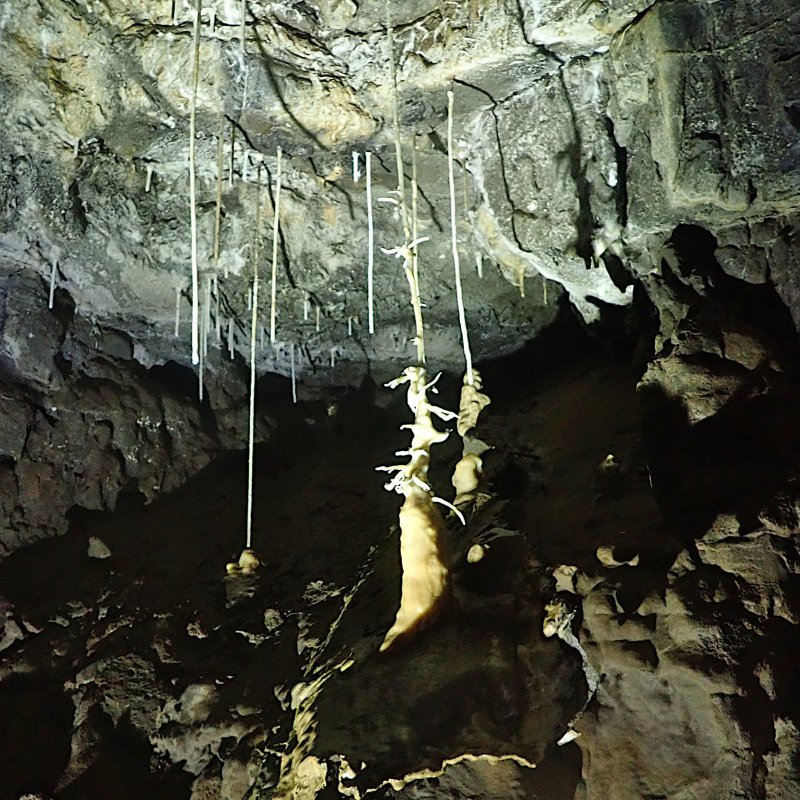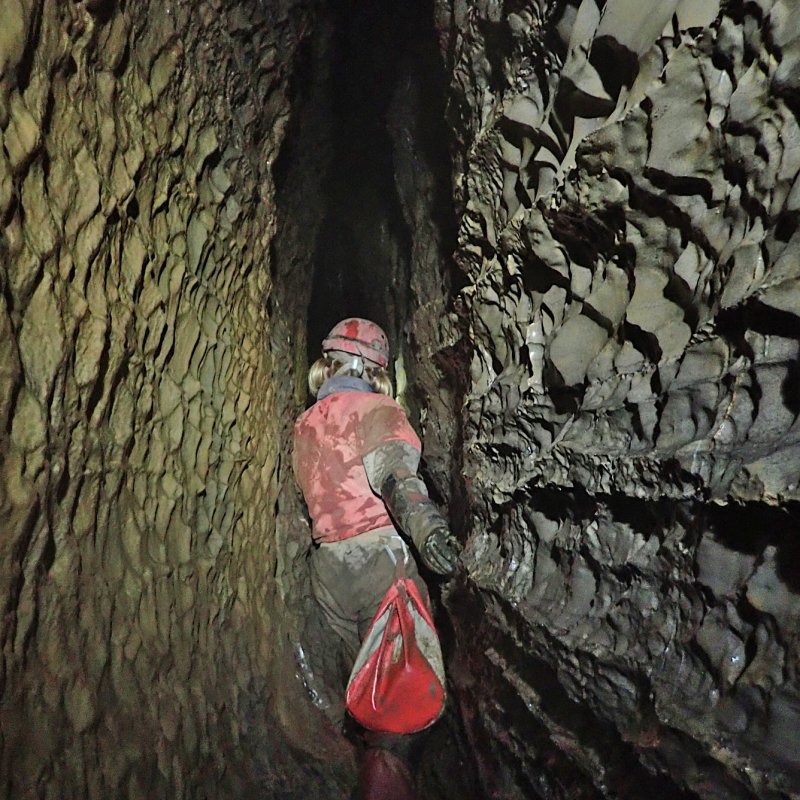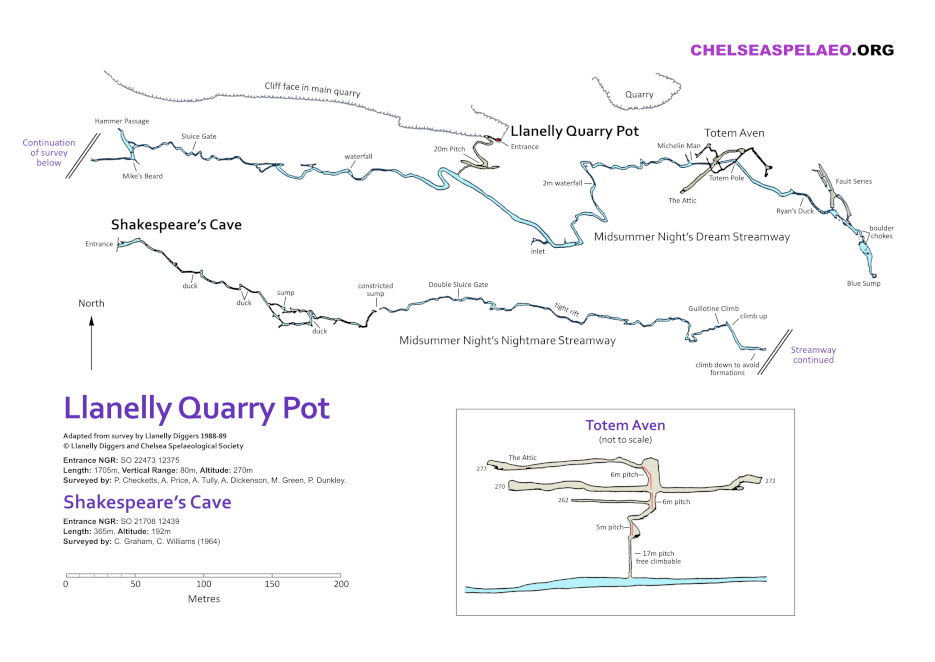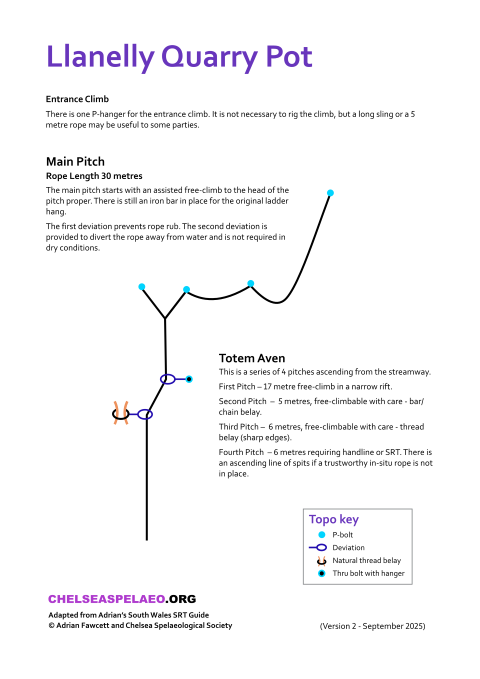Summary
Those willing to descend the somewhat awkward entrance rift are rewarded with a 20m pitch and a lengthy and varied stream passage below. The wonders of Midsummer Night’s Dream streamway make for a fine and relatively easy trip, while the addition of Midsummer Night’s Nightmare or Totem Aven makes for a more challenging excursion.
Photos by Matt Voysey
Location
NGR: SO 22468 12408 - what3words: ///bits.ogre.redeeming - Length: 1705m
Llanelly Quarry Pot is located on the flanks of Llanelly Hill, opposite Llangattock on the other side of the A465 Heads of the Valleys Road. From the village of Clydach, follow Quarry Road towards Darren-felen which contours around the hillside passing the disused Llanelly Quarry. Cars can be parked at the layby next to the archway into the quarry or at the car park at the cycleway which crosses the road at a bend a short distance beyond.
The quarry is easiest entered via the arch at the layby and a rough track heading to the left can be followed to reach the cave entrance at the far end of the quarry a short distance from the quarry cliffs.
Access
No access restrictions.
Note: The entrance rift may be impassable to cavers of a larger build. Wearing SRT kits at this point would also be an encumbrance, these are best donned later at the pitch head.
Tackle
Entrance Rift – 10m handline useful (usually in situ).
20m Pitch – SRT: 30m rope, 4 maillons, plus slings and krabs for 2 deviations, or Ladder: 20m ladder and 40m lifeline.
Totem Aven – Handline useful for pitches 2 and 3 (this can be pulled up and re-used), 15m SRT rope, 8mm hangers and bolts.
Description
Entrance Series to the Streamway – The cave entrance has been greatly improved with a newly installed plastic pipe, prior to which the cave frequently needed digging open. The pipe meets the low original entrance to a small chamber with scaffold shoring keeping boulders in place. The rift descending to the cave below is quite snug on entry and can be very awkward on the return. A handline or sling can be useful for the return and a P-hanger is in place for this purpose, though a fixed rope is usually in place. The narrow rift descends for 9m to meet a meandering stream passage which very soon emerges at a balcony at the top of a pitch. This is 20m deep and can be quite wet at times. The pitch can be rigged with either ladders or SRT, though the latter offers more scope for avoiding a wetting and prevents the problem of snagged ladders.
There is plenty of room for putting on SRT kits here and the pitch is equipped with P-hangers. The descent is rigged in two stages, with the first section being more of an assisted climb from the balcony to a ledge below. From here a short traverse leads to the pitch proper, where a Y hang can be rigged across the rift. Two deviations can be utilised below, the first (hanger) avoids rope rub while the second (natural) can be used to keep away from the water in wet conditions. Below the pitch, boulder-floored rift passage soon leads to a scaffolded 4.5m descent through boulders to a short crawl below. This was the breakthrough point for the Llanelly Diggers who first entered the streamway in 1988.
The crawl emerges into the streamway from a side wall, and it’s worth taking note of the location of this as it’s easy to miss on the return. This impressive stream passage is roughly 1200m long and has interesting water-sculpted rock and areas of formations throughout.
Upstream to the Blue Sump – It makes sense to visit the upstream section of the streamway first, as this is shorter and easier than downstream and has the most attractive features. The fine rock shelving is particularly striking in this part of the streamway. Progress is fairly straightforward, simply following the streamway with occasional sections of traversing above. A 2m waterfall is met after 170m, which is bypassed by an obvious climb up just before it (though cavers of a shorter stature may wish to use the alternative easier climb up a short distance back). Beyond this the Midsummer Night’s Dream section of the streamway begins where the passage opens out again and straws and other formations become abundant. A formation known as the Michelin Man is passed on the left and another some 30m further is the Totem Pole. Here a side passage on the right leads to the Totem Pole Extensions, which is a bit of a collector’s piece comprising a series of high-level passages reached by a succession of four pitches.
Totem Aven Series (Optional Extension)
This is rarely visited due to the technical difficulties of rigging from below. However, should you wish to take a look, here’s a summary of how it’s done. The first pitch (17m) is free-climbable with wedging, while the second and third (5m and 6m) are also free-climbable with care, but more exposed. It may be worth taking a handline to be rigged by the first person up to assist those below. The third climb reaches The Landing which has side passages to explore, while the final 6m climb above leads to the higher passage of The Attic. This climb is more exposed, slippery and committing so is best climbed using SRT. This can be rigged using a line of spits (condition unknown), to reach the top whereupon a more contemporary fixed hanger can be used to attach a rope at the top.
Roughly 50m beyond Totem Aven, Ryan’s Duck is reached, which marks the end of exploration at this end of the streamway for most as continuing beyond involves a thorough soaking and quickly meets a sump. Beyond the duck, a short section of crawling and squeezing leads to a chamber where a route above leads to the Blue Sump via a muddy wallow. The sump has been dived and found to be impenetrable.
Downstream to the Impassable Sump – Back at the point of entry to the streamway, the route downstream starts off pleasantly easy going, but gets more awkward as the passage becomes more meandering with scalloped walls and narrow sections where traversing at a higher level is necessary. This continues in the same vein for quite some time, passing through some areas of formations and a brief enlargement at Hammer Passage, before Guillotine Climb is met. This is a good turn-around point for cavers of a larger size and those not wanting to partake in the assault course of narrow squeezes and wet crawls below. However, those not put off by such things can enjoy plenty of oversuit-snagging and bruise-inducing caving fun in the Midsummer Night’s Nightmare section of the streamway beyond.
The 4.5m descent of Guillotine Climb looks quite intimidating, but has plenty of hand and footholds that are not visible from above. From this point onwards the streamway becomes more challenging with narrow rifts and squeezes until a bend with a low wet crawl. This leads to a selection of knobbly wet constrictions, until eventually easy walking passage is once again regained. The final wet crawl to the sump marks the end of the cave. This is only a short distance from the upstream sump of Shakespeare’s Cave in the Clydach Gorge, but is too narrow to pass.
Spotted an error in this route description or want to leave feedback? Contact the Webmaster.







